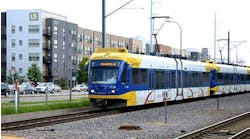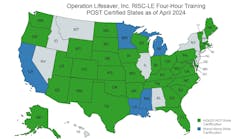A delegation of Spanish railway companies will travel from Sept. 11-18th to the United States and Canada in a new trade mission organized by the Spanish Railway Association MAFEX.
The visit of the Spanish representatives, under the coordination of MAFEX, continues the mission study conducted in March 2013 at the eighteenth annual technical forum edition of the American Association of Freight Rail Networks (Association of American Railroads, AAR) in Colorado. A journey where the emphasis was placed on the freight railway sector in North America.
United States: A country that seeks to strengthen rail exports
On this occasion, the Spanish delegation will again show its interest in becoming part of the modernization plans in the field of freight networks. It shall also meet with representatives of governments and companies in the country for investment programs in transport of passengers and the priority demands of technology and services, as well as PPP funding formulas that are expected to carry out the modernization of lines and expansion of the rail network.
In metropolitan transportation, it must be highlighted that, in recent years, the U.S. has driven numerous metro projects, and suburban light rail in major cities, with the goal of finding alternative ways to rolling traffic.
In this area, Spanish companies have found a way of consolidation in the country and a path to internationalization, since there are many firms involved in the implementation of these networks in all fields of activity. Among them are the metros of Washington, New York, San Francisco and Miami, the tram in Houston, the articulated units in Pittsburgh and Sacramento or the light rail systems in Saint Louis and Austin, Texas.
In the medium term, network expansions in several cities are expected. A series of investment plans that can benefit the Spanish railway industry. The transport authorities have already anticipated that Houston will increase by adding five lines plus its light rail system, while Denver (Colorado) will invest 4,900 million euros to create a commuter and tram network. Also, Los Angeles will continue with the expansion of its suburban service.
Along the metropolitan transport, there are good prospects with high-speed plans in California, which have recently begun with the award to an American consortium of civil works of the first section between the towns of Madera and Fresno. This project, which will connect San Francisco, Sacramento, Los Angeles and San Diego, opens new options for business expansion for the MAFEX associated companies in the United States, a key strategic objective in the internationalization of the Spanish railway sector which aims to increase its market share in this country.
Canada: great opportunities in passenger and freight traffic
The second part of MAFEX’s trade delegation will focus on a series of contacts and meetings of the Spanish representatives with administrations and companies from the Canadian transport sector. This country also has plans to improve and expand both commuter and metro networks.
Cities such as Montreal, Vancouver, Edmonton, Calgary and Toronto will increase the extent of their networks, while other urban nucleus are studying the implementation of these transport means in order to meet the demand for public transport and improve mobility. All with viable solutions from an economic point of view and with low environmental impact such as rail connections. There are light rail projects in various cities of the province of Ontario among which are the plans of the municipalities of Ottawa (Confederation Line), Hamilton (Hamilton Street Railway), Kitchener-Waterloo (K-Wlight rail) and Mississauga-Brampton (Hurontario-Main Street LRT). Meanwhile, in Quebec there is also an initiative to build a line of these features (Quebec City LRT), as well as in Vancouver (Downtown Streetcar) and Victoria (Douglas Street light-rail). To these are added, within the province of Manitoba, the transportation program of the city of Winnipeg (Winnipeg Rapid Transit).
Besides, there are studies that examine the need to increase passenger traffic of VIA Rail (Renfe’s equivalent in Canada), especially in corridors as the Quebec-Windsor, on key sections such as the Montreal/Ottawa/Toronto. Also, they want to reduce the travel times in other routes in the country.
In order to take forward these initiatives, the Federal Government has approved the plan "Building Canada", in force from 2007 to 2014, which devotes a large public investment, valued at 27. 574 million euros, to improve infrastructure.
High speed: Corridors with future prospects
In terms of high speed, Canada, who doesn’t count yet with any network of these characteristics, analyses several axes for the future, largely to cover the north-south routes and connect with major cities around the United States: Vancouver-Seattle, Toronto-Chicago and Montreal-Boston and New York. In addition, internal branches are being studied such as the Quebec-Windsor or the Calgary-Edmonton.
With this new branch office, MAFEX aims to boost the presence of Spanish companies in two countries where there are large business and growth prospects for the Spanish railway industry. Also, the working agenda will give the opportunity to know more closely the peculiarities and characteristics of financing and collaborating in public-private partnership projects in the U.S. and Canada.



